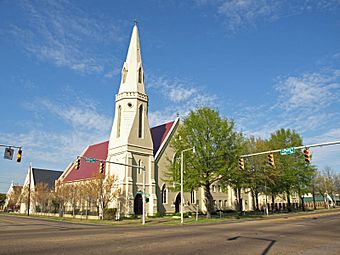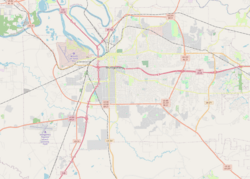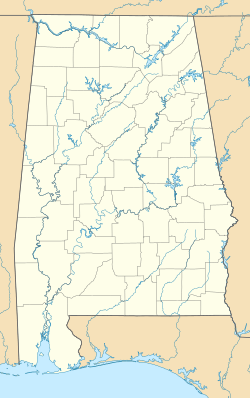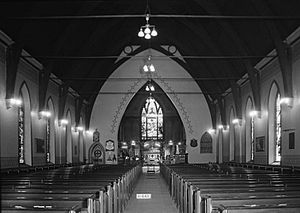St. John's Episcopal Church (Montgomery, Alabama) facts for kids
Quick facts for kids |
|
|
St. John's Episcopal Church
|
|

St. John's Episcopal Church in 2009.
|
|
| Location | 113 Madison Ave., Montgomery, Alabama |
|---|---|
| Area | less than one acre |
| Built | 1854-55 |
| Architect | Frank Wills; Henry Dudley |
| Architectural style | Gothic Revival |
| NRHP reference No. | 75000326 |
| Added to NRHP | February 24, 1975 |
St. John's Episcopal Church is a very old and beautiful church in Montgomery, Alabama, United States. It was built in a style called Gothic Revival, which looks a bit like old castles or cathedrals. Two architects from New York City, Frank Wills and Henry Dudley, designed this special building. Because of its history and unique style, the church was added to the National Register of Historic Places on February 24, 1975. This means it is recognized as an important historical site.
Contents
Church History
Early Beginnings
The St. John's church community started in 1834. By 1837, the church members had a simple brick building. It was located at the corner of Perry and Jefferson Streets.
Just over ten years later, the church needed more space. This was because Montgomery became the state capital. Also, more people moved to the area due to a rise in cotton farming. The church you see today was finished in 1855. It was built on the same city block as the old one, but it faced Madison Street.
A Role in American History
St. John's Episcopal Church was part of several important events. These happened around the time of the American Civil War. In 1861, it hosted a meeting of Southern churches. This meeting helped to support the idea of Southern states leaving the United States.
Jefferson Davis, who was the president of the Confederate States of America, attended this church. Montgomery was the capital of the Confederacy at that time. In 1865, the church had to close its doors. This was ordered by the Union Army. It reopened for services in 1866.
Changes and Growth
The original church building from the 1830s was taken down in 1869. Its bricks were used to add to the main church building. The church was made even bigger in 1906.
During World War I, many Army recruits visited the church. They came from a nearby camp called "Camp Sheridan." However, the church had to close temporarily in 1918. This was due to the Spanish flu pandemic, a widespread illness.
Helping Children and Education
From 1898 to 1901, a leader named Edgar Gardner Murphy worked at St. John's. He was very important in starting groups to help children. He helped create the Alabama and then the National Child Labor Committee. These groups worked to set strict rules on how old children had to be to work in factories.
In 1901, he left St. John's to lead the Southern Education Board. This group worked to make education better in the Southern states. They especially focused on public schools.
A Time for Reflection
In May 1925, a special bronze plaque was put up. It honored President Jefferson Davis. A speaker named John Trotwood Moore gave a speech at the dedication.
In 2019, the church leaders looked closely at the history of this plaque. They also looked at a pew (a church bench) dedicated to Davis in 1931. They learned more about the ideas and reasons behind these dedications. The church leaders decided to remove the plaque and the pew from the main church area. They moved them to the church's historical records. This decision was made to ensure the church's symbols reflect values of fairness and equality for everyone.
Modern Renovations
The church building was updated in the 1950s. It was renovated again in 2006. These updates help keep the historic building strong and beautiful for future generations.
See also





